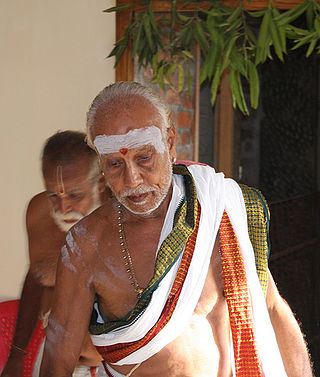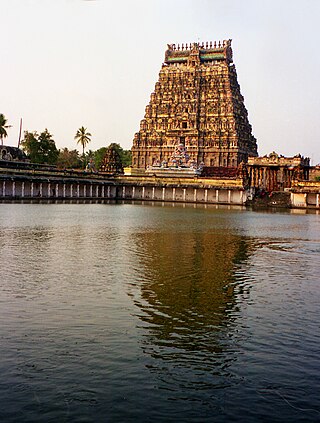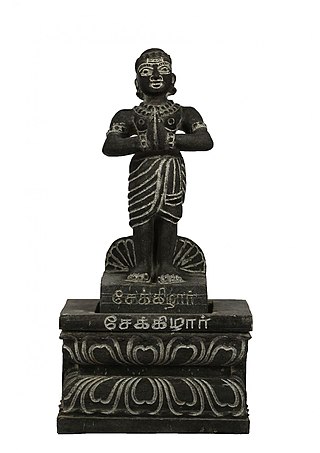
Iyers are an ethnoreligious community of Tamil-speaking Brahmins. Most Iyers are followers of the Advaita philosophy propounded by Adi Shankara and adhere to the Smarta tradition. This is in contrast to the Iyengar community, who are adherents of Sri Vaishnavism. The Iyers and the Iyengars are together referred to as Tamil Brahmins. The majority of Iyers reside in Tamil Nadu, India.

Chidambaram is a major town and municipality in Cuddalore district in the Indian state of Tamil Nadu, on the banks of the Vellar River where it meets the Bay of Bengal. It is the headquarters of the Chidambaram taluk. The town is believed to be of significant antiquity and has been ruled, at different times, by the Pallavas until ninth century, Medieval Cholas, Later Cholas, Later Pandyas, Vijayanagara Empire, Thanjavur Nayakas, Marathas and the British. The town is known for the Thillai Nataraja Temple and Thillai Kali Temple, and the annual chariot festival held in the months of December–January and June to July. One of the Divya Desams Divya Sri Govindaraja Perumal Temple (Thiruchitrakoodam) is a part of Thillai Nataraja Temple complex. Thiruvetkalam Shiva Temple, Vadakiruppu, Thirunelvayil Shiva Temple, Sivapuri and Tirukkazhippalai Palvannanathar Temple are the other three ancient Shiva temples in the region.

Kulottunga Chola I also spelt Kulothunga, born Rajendra Chalukya, was a Chola Emperor who reigned from 1070 to 1122 succeeding his cousin Athirajendra Chola. He also served as the Eastern Chalukya monarch from 1061 to 1118, succeeding his father Rajaraja Narendra. He is related to the Chola dynasty through his mother's side and the Eastern Chalukyas through his father's side. His mother, Ammangaidevi, was a Chola princess and the daughter of emperor Rajendra Chola I. His father was king Rajaraja Narendra of the Eastern Chalukya dynasty who was the nephew of Rajendra and maternal grandson of Rajaraja Chola I. According to historian Sailendra Nath Sen, his accession marked the beginning of a new era and ushered in a period of internal peace and benevolent administration. He was succeeded by his son Vikrama Chola

Purohita, in the Hindu context, means chaplain or family priest within the Vedic priesthood. In Thailand and Cambodia, it refers to the royal chaplains.

Sēkkilān Mādēvadigal Rāmadēva, known popularly by his family name as Sekkizhar, was a saint and a contemporary of Kulottunga Chola II. He compiled and wrote the Periya Puranam in 4253 verses, recounting the life stories of the sixty-three Shaiva Nayanars, the devotees of Shiva. Sekkilhar himself was later canonised and his work, the Periyapuranam became the twelfth and final book of the sacred Saiva canon.

Parantaka Chola I was a Chola emperor who ruled for forty-eight years, annexing Pandya by defeating Rajasimhan II and in the Deccan won the Battle of Vallala against Rashtrakutas which happened before 916 CE. The best part of his reign was marked by increasing success and prosperity.
Vellalar is a group of castes in the Indian states of Tamil Nadu, Kerala and northeastern parts of Sri Lanka. The Vellalar are members of several endogamous castes such as the numerically strong Arunattu Vellalar, Chozhia Vellalar, Karkarthar Vellalar, Kongu Vellalar, Thuluva Vellalar and Sri Lankan Vellalar.

Vikrama Chola, known as Kō Parakēsari Varman, was a 12th-century ruler of the Chola Empire in southern India. He succeeded his father Kulothunga I to the throne. Vikrama Chola was crowned as the heir-apparent by his father early in his life. He was appointed as viceroy of the Vengi province in 1089 C.E., succeeding his brother Rajaraja Chodaganga. Vikrama during his tenure successfully managed to check the ambitions of the Western Chalukya Vikramaditya VI on the Vengi kingdom.Vikrama Chola inherited the territories which included Tamil Nadu and some parts of Andhra Pradesh.

Kulothunga II was a Chola Emperor from 1133 CE to 1150 CE. He succeeded Vikrama Chola to the throne in 1135 CE. Vikrama Chola made Kulothunga his heir apparent and coregent in 1133 CE, so the inscriptions of Kulothunga II count his reign from 1133 CE. According to historians Nilakanta Sastri and T.N Subramanian, Kulottunga Chola II was not the son of Vikrama Chola and they have suggested that there was a break in the line of succession.

The Nambudiri, also transliterated as Nampoothiri, Nambūdiri, Namboodiri, Namboothiri and Nampūtiri, are a Malayali Brahmin caste, native to what is now the state of Kerala, India, where they constituted part of the traditional feudal elite. Headed by the Azhvanchery Thamprakkal Samrāṭ, the Nambudiris were the highest ranking caste in Kerala. They owned a large portion of the land in the region of Malabar, and together with the Nair monarchs, the Nambudiris formed the landed aristocracy known as the Jenmimar, until the Kerala Land Reforms starting in 1957.

Thillai Nataraja Temple, also referred as the Chidambaram Nataraja Temple, is a Hindu temple dedicated to Nataraja, the form of Shiva as the lord of dance. This temple is located in Chidambaram, Tamil Nadu, India. This temple has ancient roots and a Shiva shrine existed at the site when the town was known as Thillai. Chidambaram, the name of the city literally means "stage of consciousness". The temple architecture symbolizes the connection between the arts and spirituality, creative activity and the divine. The temple wall carvings display all the 108 karanas from the Natya Shastra by Bharata Muni, and these postures form a foundation of Bharatanatyam, an Indian classical dance.

Nandanar, also known as Thirunaallaippovaar and Tirunallaipovar Nayanar, was a Nayanar saint, who is venerated in the Hindu sect of Shaivism. He is generally counted as the eighteenth in the list of 63 Nayanars. Like the other Nayanars, he was a devout devotee of the god Shiva.

Tirupperunthurai is located in Avudaiyarkoil village, near Aranthangi in the Pudukkottai district of Tamil Nadu. It was built to honor Lord Shiva. One of the sacred books of Tamil Saiva Siddhanta, Manikkavasagar's Tiruvasakam, originated from this shrine. Manikkavasagar is said to have converted the king to follow Shiva, and built the temple with money that had been intended for war-horses.
Thirunaraiyur Nambiyandar Nambi was an eleventh-century Shaiva scholar of Tamil Nadu in South India who compiled the hymns of Sambandar, Appar and Sundarar and was himself one of the authors of the eleventh volume of the canon of the Tamil liturgical poetry of Shiva, the Tirumurai.

Sattainathar temple, Sirkazhi is a Hindu temple dedicated to Shiva located in Sirkali, Tamil Nadu, India. The temple is incarnated by the hymns of Thevaram and is classified as Paadal Petra Sthalam. It is an ancient temple complex with three different Shiva shrines in three stories.
Hinduism in Tamil Nadu finds its earliest literary mention in the Sangam literature dated to the 5th century BCE. The total number of Tamil Hindus as per 2011 Indian census is 63,188,168 which forms 87.58% of the total population of Tamil Nadu. Hinduism is the largest religion in Tamil Nadu.

The Govindaraja Perumal Temple, also called Thiruchitrakoodam, is a temple situated in Chidambaram, a town in the South Indian state of Tamil Nadu. Dedicated to the Hindu god Vishnu, the temple is inside the premises of the Thillai Nataraja Temple, constructed in the Dravidian architecture. The temple is glorified in the Naalayira Divya Prabandham, the early medieval Tamil canon of the Alvar saints from the 6th–9th centuries CE. It is one of the 108 Divya Desam dedicated to Vishnu, who is worshipped as Govindaraja Perumal and his wife Lakshmi as Pundarikavalli Thayar.

Kutruva Nayanar, also known as Kootruva , Kutruva, Kutruvar, Kootruvar, Kurruva Nayanar, Kurruvar, Kurruvan, Kutruvanar, Kurrrruvar and Kalappalar, was a chieftain of Kalandai and a Nayanar saint, venerated in the Hindu sect of Shaivism. He is generally counted as the 39th in the list of 63 Nayanars. Kutruva is often described as a Jain, who became a devotee of Shiva, the patron god of Shaivism.

Cheraman Perumal Nayanar was a bhakti poet-musician and religious teacher of Tamil Shaiva tradition in medieval south India. The Cheraman Perumal's friendship with Sundarar, one of the 'Three Nayanars', is celebrated in the bhakti tradition. The legend of the Cheraman Perumal is narrated in the hagiographic Periyapuranam, composed by Chekkizhar, a courtier of Chola Kulottunga II, in mid-12th century AD. The collection is based on an earlier work by Nambiyandar Nambi. Thiruvanchikulam Siva Temple in Kodungallur is associated with the Perumal and Chundaramurtti Nayanar.
Naralokaviran, also known as Kalinga Rayan, was a general in the Chola army during the reign of Kulottunga I and his successor Vikrama Chola. He was the headman of Arumbakkam and a resident of Manavil in Manavil Nadu in Tondai Mandalam. He maintained a large fief at Manavil. Naralokaviran led many Chola campaigns in the deep south and distinguished himself in the Pandya Wars. He had many titles like Madurantaka Ponnambala-koothar, Sabharnataka, Kalinga Rayan, Porkoyil-Tondaiman, Koothan, Tondaiyarkon, the Lion of Kalinga.















